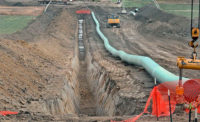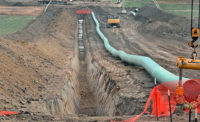The Dakota Access Pipeline may yet be built. Then again, it may not. A year ago, this was not in question. Today, the 1,172-mile-long, $3.78-billion project is more than half-built but it lacks a permit for just 1,094 ft—one-fifth of a mile—on federal property, and the U.S. government has ordered permitting suspended pending further review. Now, after a series of political successes, opponents are dreaming of halting the entire project, as happened with the Keystone XL Pipeline. How could this situation have been avoided?
Start by considering the reason for the intense opposition to the project. The permit for a crossing of Lake Oahe, created by a dam on the Missouri River, has been suspended. The crossing is a half-mile upriver from the Standing Rock Sioux Tribe’s reservation. The tribe relies on the Missouri River for its water supply and fears that a leak in the 30-in. pipeline, though deeply buried, could enter the river and reach the tribe’s intake pipe before it could be closed. In a federal lawsuit, the tribe says, “The construction and operation of the pipeline, as authorized by the [U.S. Army Corps of Engineers], threatens the Tribe’s environmental and economic well-being, and would damage and destroy sites of great historic, religious, and cultural significance to the Tribe.” The tribe further claims “the Corps’ final permit decision is the product of a fundamentally flawed consultation process that does not meet the requirements of the [Advisory Council on Historic Preservation] regulations.”
Without going into the details of the claims, counterclaims and disputes surrounding this controversy, one can say with confidence that it is about more—a lot more—than water and adherence to regulations. If the Standing Rock Sioux Tribe were alone in this protest, it would be at most a local environmental dispute. The fact that it has drawn protesters from more than 300 tribes all over North America suggests that it has ripped a scab off a deep wound. That wound is the searing injustice committed against the indigenous people of this continent by a government and society whose cultural values in some respects are fundamentally different from theirs and who have run roughshod over the Native people whenever meeting them and negotiating with them as equals was inconvenient.
The mismatch of cultural values can be seen in some of the statements of the project’s defenders and promoters. Jack Gerard, president and CEO of the American Petroleum Institute, citing polls it has commissioned, has said the opponents “have a fundamental view that is inconsistent with where the American voter is” with respect to support for increased energy production, that their opposition will increase gasoline prices and slow the economy.
Jim Volker, CEO of Whiting Petroleum, North Dakota’s largest oil producer, has said the standoff could be solved by extending economic opportunities such as jobs and contracts to the Native Americans. Such benefits certainly would help, but respect for the history of mistreatment suffered by Native peoples and their consequent sensitivity to the smallest slights would earn non-Native business people respect and better cooperation from the Native people they hope to influence. And acknowledgment of a spiritual dimension to life would help non-Natives see that economic arguments must be leavened with appreciation of the Native peoples’ deep spiritual connection with their heritage, the Earth and their small piece of it.
Whatever else may be said about this conflict, that there was a failure of communication is indisputably clear.
The American can-do spirit is a world-renowned national asset and justly so. It has produced a society and industrial economy that are the wonder and envy of the world. But a touch of humility is necessary. “Can do” is only one stone in the nation’s cultural mosaic. We neglect that truth at our peril. As a nation of immigrants, whose diversity increases every year with new infusions from all parts of the globe, we have demonstrated an unparalleled ability to accommodate diverse cultural views and practices with relatively little friction. We still have work to do, however, in understanding and respecting the culture of the people who were here to greet the Pilgrims, the Virginia settlers and the Spanish conquistadores—the Native Americans. Our forebears didn’t try to meet them as equals and integrate them in a national society; they simply conquered, subjugated and colonized them. Our forebears devalued the Native American culture, did their best to eradicate it and set up their own values and cultural practices as the norm for the Native peoples to accommodate. With the perspective of that history, we can alter the future.
Tom Armistead is the consulting editor of ENR Energy. After a 23-year career in construction, he served 12 years as ENR’s editor for power and industrial news and subsequently for energy news.



Post a comment to this article
Report Abusive Comment